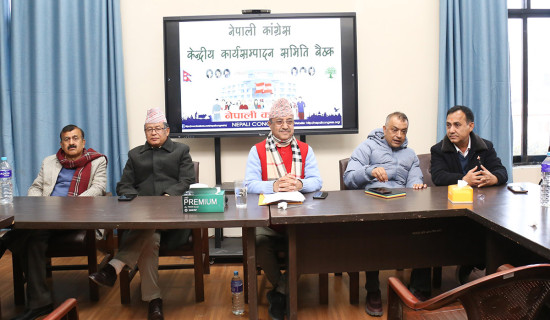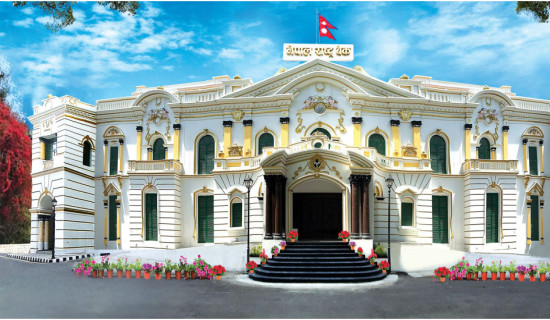- Friday, 2 January 2026
Lumbini: Where Spirituality, Tourism Converge
Imagine standing in a tranquil garden
where sunlight dances through the trees, leading you toward a sacred
monument—the Maya Devi Temple. This site marks the birthplace of Gautam Buddha,
the founder of Buddhism. Born as Siddhartha Gautama in 563 BCE, Buddha’s
journey from a prince surrounded by luxury to a seeker of spiritual truth
inspires millions around the world today. Lumbini, Nepal, holds the essence of
this transformative journey.
Buddhism’s core teachings — the Four Noble Truths and the Eightfold Path — guide individuals toward a life free from suffering. The Four Noble Truths acknowledge that suffering exists and arises from desire, can end, and that there is a path toward peace. The Eightfold Path offers a practical guide on how to lead a meaningful life through right understanding, thought, speech, action, livelihood, effort, mindfulness, and concentration. These principles transcend time and culture, offering wisdom for all, regardless of where they come from or what they believe.
Bustling
destination
Today, Buddhism has spread across the
globe, with around 500 million followers. Lumbini, once a quiet pilgrimage
site, has grown into a bustling destination, drawing between 500,000 and 1
million visitors annually. Pilgrims and tourists alike come from around the
world to walk in the footsteps of Buddha and reflect on the values of peace and
compassion that his teachings represent.
Lumbini is more than just an ancient
site; it is a living testament to Nepal’s rich spiritual and cultural heritage.
The Maya Devi Temple marks the exact spot where Siddhartha Gautama was born.
Nearby, the Ashoka Pillar, erected by Emperor Ashoka in the 3rd century BCE,
stands as a symbol of Lumbini’s long-standing importance to Buddhists. The site
is a beautiful mosaic of monasteries, meditation centres, and temples built by
Buddhist communities from across the world. From the Japanese Peace Pagoda to
the Korean Buddhist Temple, each structure reflects the diversity and unity of
the global Buddhist community.
Beyond its spiritual significance, Lumbini plays a key role in Nepal’s tourism economy. As visitors flock to this sacred site, they create opportunities for local businesses. Hotels, restaurants, guides, and artisans benefit from the steady stream of pilgrims and tourists, making Lumbini an essential part of the local and national economy. It’s a place where spirituality and economic opportunity coexist, offering a lifeline to the local community.

However, Lumbini’s growing popularity
brings with it the challenge of sustainable development. Balancing the need to
accommodate more visitors with the importance of preserving the site’s natural
beauty and spiritual sanctity is critical. Sustainable tourism practices are
essential to ensure Lumbini remains a serene, clean, and welcoming place for
future generations. Simple measures like waste management, water conservation,
and the use of renewable energy can go a long way in maintaining the area’s
pristine environment.
Local communities are central to
Lumbini’s sustainability. When locals are involved in tourism — whether as
guides, entrepreneurs, or artisans — they are empowered to protect and share
their cultural heritage. Promoting eco-tourism and sustainable agriculture in
the surrounding areas will not only support conservation efforts but also
provide additional income sources for local families. This is where the role of
the Non-Resident Nepali (NRN) community becomes crucial. NRNs, living abroad
but deeply connected to their homeland, are in a unique position to promote Lumbini
as a global shrine of peace and spirituality. Their efforts can shine a
spotlight on Lumbini, bringing its cultural and spiritual significance to a
broader international audience.
NRNs can play a pivotal role in raising
awareness of Lumbini through international platforms. By organising
conferences, cultural events, and exhibitions, they can highlight Lumbini’s
importance as a key Buddhist pilgrimage site. Through social media,
publications, and outreach initiatives, NRNs can introduce Lumbini to audiences
who may never have considered it a destination, thus increasing its global
visibility.
Another way NRNs can support Lumbini is
by investing in its tourism infrastructure. Enhancing visitor services — such
as improving hotels, transportation, and guides — will help accommodate the
increasing number of tourists while ensuring a high-quality experience. These
investments not only benefit visitors but also provide economic opportunities
for local residents, ensuring that Lumbini’s growth benefits the entire
community.
Education is a key area where NRNs can
make a lasting impact. Supporting research, publications, and documentaries
about Lumbini’s history and spiritual significance can deepen global
understanding. These efforts help share Lumbini’s story with people who may
never have the chance to visit, preserving its legacy in the minds and hearts
of people around the world.
In promoting Lumbini, NRNs also have the
responsibility to advocate for sustainable practices. By pushing for eco-friendly tourism and supporting local
conservation efforts, NRNs can help ensure that Lumbini’s development does not
come at the cost of its natural and spiritual beauty. Preserving its
sanctity for future generations is as important as expanding its tourism
potential.
Collaboration with international
Buddhist communities is another powerful way to elevate Lumbini’s profile.
Joint events, such as Buddhist festivals and global conferences, can draw even
more visitors, creating cultural exchanges that enrich both Lumbini and the
global Buddhist community. These events foster a sense of shared purpose and
unity among Buddhists worldwide, all while highlighting the significance of
Buddha’s birthplace.
Sustainable
practices
Moreover, working closely with Buddhist
leaders and organisations can lead to initiatives that both protect and promote
Lumbini. Engaging in these partnerships opens doors to new ideas and practices
that can help Lumbini thrive as a global destination while safeguarding its
historical and spiritual essence. In conclusion, Lumbini stands not just as the
birthplace of Gautam Buddha but as a symbol of peace, hope, and spiritual
reflection for people from all walks of life. Its global importance as a
pilgrimage site continues to grow, attracting between 500,000 and 1 million
visitors each year. As tourism flourishes, the challenge remains to balance
development with preservation, ensuring that Lumbini remains a sacred place of
peace for generations to come.
The Non-Resident Nepali community, with
its deep connections to Nepal and its global reach, has a critical role in this
mission. Their efforts to promote Lumbini, invest in its infrastructure, and
advocate for sustainable practices will help ensure that this sacred site
continues to inspire and uplift millions. Through collaboration, education, and
mindful development, Lumbini will remain a beacon of peace and spirituality for
the world, honouring the legacy of Gautam Buddha and benefiting all who come to
seek enlightenment.
(The author is deputy general secretary of International Coordination Council, Non-Resident Nepali Association.)
















